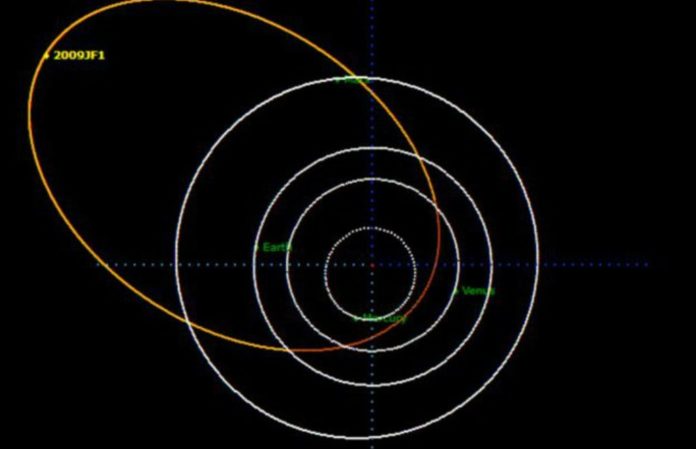It is 2009 JF1 celestial body, which could collide with our planet on May 6 of next year at 08:34 hours
An explosion with the power of 150 Hiroshima bombs could leave an apocalyptic scenario on Earth in 2022. Much was said about the end of the world in 2012, but it seems that, according to NASA, this prediction could occur ten years later, that is, next year.
The National Aeronautics and Space Administration (NASA) has defined asteroid 2009 JF1 as “potentially dangerous” as it could hit Earth on March 6, 2022, at 08:34 hours, with the probability of impact, is 1 in 3,800 (0.026%).
The date set for the collision has been realized following the complete observation of the asteroid through a collision monitoring system of the US space agency that catalogs near-earth objects according to their size, speed, dimensions, and year in which the impact is believed to occur.
This space rock is considered “potentially dangerous” by NASA, which has described it as a Near-Earth Object (NEO), meaning it is close enough to be considered a threat to Earth. Asteroids are celestial bodies, which move in orbits, either of little or considerable eccentricity around the Sun, and whose inclination over the elliptical can be of any angle.
“Some asteroids and comets follow orbital paths that take them much closer to the Sun than usual and, therefore, to the Earth,” NASA explains in a statement. These asteroids are constantly monitored by NASA’s Jet Propulsion Laboratory, using an automated system called the Sentry. This system manages to measure a large amount of data that allows us to determine, for example, that 2009JF1 is an Apollo asteroid, that means its orbit around the Sun is larger than that of the Earth.
- Scientists in Fear of This New Predator From Red Sea Eating Native Species in Mediterranean
- Does This Mean We Stopped Being Animal and Started Being Human Due to ‘Copy Paste’ Errors?
- The One Lifestyle Choice That Could Reduce Your Heart Disease Risk By More Than 22%
- Aging: This Is What Happens Inside Your Body Right After Exercise
- Immune-Boosting Drink that Mimics Fasting to Reduce Fat – Scientists ‘Were Surprised’ By New Findings
According to NASA, “Sentry is a highly automated collision monitoring system that continuously scans the latest asteroid catalog for future impact with Earth over the next 100 years. Whenever a potential impact is detected it will be analyzed and the results will be published immediately here, except in unusual cases where we seek independent confirmation. It is normal that, as additional observations become available, objects disappear from this table when there are no longer detections of possible impacts. For this reason, we keep a list of deleted objects with the deletion date.”
Asteroid 2009 JF1 is currently 375,587,595 km from the planet, approaching 18 km towards us every second. It flies beyond Earth at incredible speed, at 65,293 kilometers per hour. The Space Agency visualized it through Sentry in 2009, estimating that it measures about 13 meters in diameter. Its impact on Earth could cause an explosion equivalent to 230 kilotons of dynamite. It must be calculated that the Hiroshima bomb had only fifteen kilotons of power.
Although the probability of collision is very low, smaller rocks that usually accompany the space body can enter our atmosphere, burn in it as they descend to the ground, creating meteors and meteorites that we often see as showers of stars in the night sky.
Missions to attack or divert asteroids
Space agencies are currently working to develop missions to attack these asteroids that pose a threat to the planet and be able to divert them from their trajectory.
Such is the case of the DART spacecraft, which will be launched in mid-2021 with the aim of colliding with Dimorphos, one of the most dangerous asteroids for Earth by its characteristics. DART is part of NASA’s Hera mission in collaboration with the European Space Agency (ESA).
